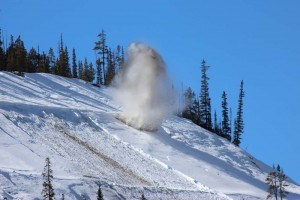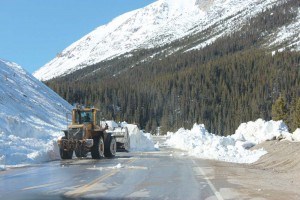
Last Friday may have been April Fool’s Day, but it was a day of serious business for Jasper National Park’s visitor safety team. The day’s weather conditions turned out to be perfect for avalanche control at four points along the Icefields Parkway: Wilcox Pass trailhead, Parker Ridge, Mount Saskatchewan and the gravel slopes at Bridal Veil Falls. Conditions were also good for control work at Medicine Slabs on Maligne Lake Road.
The sudden burst of warm weather during the daytime and minimal overnight freezing during the previous week made snow packs more likely to slide off mountain slopes and hit the road, putting the travelling public at risk. With many tour operators being closed for the winter season and the low traffic levels, this was an excellent time to close parts of the parkway to do controlled avalanches and safely clear debris.
Avalanche control involves closing a section of a road or a stretch of highway and using explosives to safely start an avalanche while the roadway is closed to traffic. The visitor safety team uses helicopters or a ground-based avalauncher to deliver the explosive charges to the right place on a slope to set-off an avalanche. Avalanche control lets Parks Canada manage risks by ensuring the avalanche occurs when the roadway is closed to traffic.
This work takes a lot of preparation to ensure the safety of the workers and the travelling public as well as to keep the road closure as short as possible. A public notice was sent out on March 29 to alert the travelling public and Jasper residents of the date and times for the avalanche control operation. The closure took place from near Rampart Creek in the south to Parker Ridge in the north.
On Friday, the avalanche control team kicked off the day with a preparation meeting at 10 a.m. The team reviewed the sites chosen for avalanche control, the latest weather conditions, the roles for each member of the team, the radio frequencies to be used during the operation and the timings for each step of the day’s operation. The team included a park warden for traffic control, visitor safety specialists who would prepare and drop the explosive charges to start the controlled avalanches, as well as snow plow crews from the highway operations unit to remove the debris after the avalanche. A helicopter was also chartered for the operation.
The team members used the rest of the morning to move their equipment into place at Parker Ridge parking lot to set-up and await the arrival of the helicopter. Parks Canada staff prepared the explosives and did a safety briefing during the wait and put on their avalanche beacons. The helicopter arrived at 2 p.m. and the pilot did a short safety briefing about the helicopter for the four visitor safety specialists who were to fly on the mission.

The Parks Canada incident commander also briefed the pilot on the avalanche control locations and reviewed the signals to be used by the crew when dropping the explosive charges. At the same time, the highway crew closed the Icefields Parkway north of the first controlled avalanche site while a park warden drove south along the parkway looking for vehicles parked along the closure zone. Notices were left on parked vehicles to warn park users about the operation and the related road closure times. Park users were advised to stay in place until the avalanche operation was completed and the closures lifted.
The helicopter took off around 2:30 p.m. and dropped two explosive charges on the slope near the trailhead for Wilcox Pass. No avalanches occurred, showing that the slope was stable. The crew moved on to Mount Saskatchewan where four charges were dropped. The snow pack stayed in place there as well. The helicopter flew back to Parker Ridge to pick up more explosives before flying to the gravel flats near Bridal Veil Falls. Here the two charges that were dropped successfully released an avalanche that covered both lanes of the parkway to an average depth of one metre and covering over 100 metres of highway.
Large front-end loaders from Jasper National Park’s highway operations unit sprang into action and cleared the road in about 30 minutes. Once the debris was cleared and visitor safety specialists confirmed the mountain slope was safe, the Icefields Parkway was re-opened at 6 p.m. The helicopter crew flew on to Maligne Road where nine explosive charges were dropped at Medicine Slabs and near the Shangri-la trailhead at Big Bend. Seven size two avalanches were triggered along Medicine Slabs with one stopping 150 metres short of the road and the other putting a trickle of snow on the road near Shangri-la trailhead.
Maligne Road was closed on Friday night at 8 p.m. and was re-opened on Saturday morning at 9 a.m.
Spring avalanche conditions are still in effect along the Icefields Parkway. It is possible that more avalanche control operations will take place over the coming weeks. Highway 93 south of the Columbia Icefields may be closed on short notice to allow visitor safety specialists to deal with any avalanche hazards.
Please visit www.pc.gc.ca/avalanche for the latest avalanche bulletins or visit www.511.alberta.ca to find the most up-to-date information on road closures and delays in Jasper National Park.
Parks Canada
Special to the Fitzhugh
